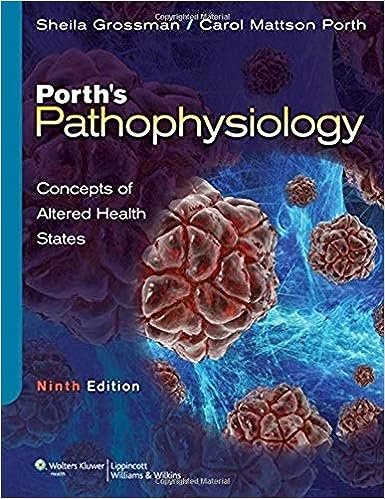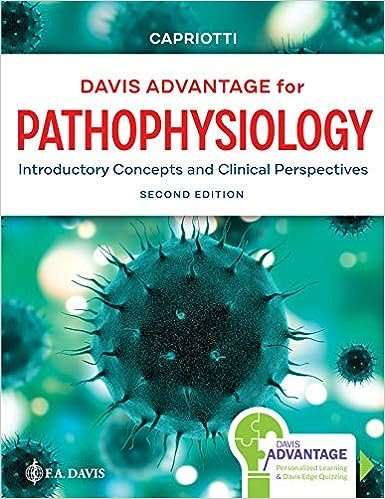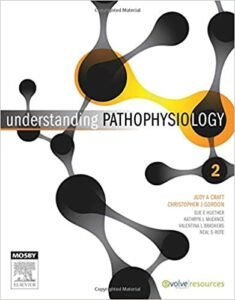Test Bank for Porth’s Pathophysiology 10th Edition Norris
1. While batting, a baseball player is struck in the ribs by a pitch. Place the following
components of the player’s pain pathway in the chronological order as they contribute to
the player’s sensation of pain. Use all the options.
A) Thalamus
B) Dorsal root ganglion body
C) Dorsal root ganglion periphery
D) Axon
E) Cerebral cortex
Ans: C, B, D, A, E
Feedback:
All somatosensory information from the limbs and trunk shares a common class of
sensory neurons called dorsal root ganglion neurons. Somatosensory information from
the face and cranial structures is transmitted by the trigeminal sensory neurons, which
function in the same manner as the dorsal root ganglion neurons. The cell body of the
dorsal root ganglion neuron, its peripheral branch (which innervates a small area of
periphery), and its central axon (which projects to the CNS) communicate with the
thalamus, which in turn communicates with the cerebral cortex using third-order
neurons.
2. A student is feeling inside her backpack to find her mobile phone. There are a number
of other items in the bag other than the phone. The nurse knows that which of the
following terms best describes one’s ability to sense of shape and size of an object in the
absence of visualization?
A) Stereognosis
B) Astereognosis
C) Modalities
D) Somesthesia
Ans: A
Feedback:
NURSINGTB.COM
The sense of shape and size of an object in the absence of visualization is known as
stereognosis. Astereognosis is a deficit whereby a person can correctly describe the
object but does not recognize it. “Modalities” is a term used for qualitative, subjective
distinctions between sensations such as touch, heat, and pain. Somesthesia describes
most of the perceptive aspects of body sensation and requires the function of the parietal
association cortex.
3. A woman with severe visual and auditory deficits is able to identify individuals by
running her fingers lightly over their face. Which of the following sources is most likely
to provide the input that allows for the woman’s unique ability?
A) Pacinian corpuscles
B) Ruffini end organs
C) Meissner corpuscles
D) Free nerve endings
Ans: C
Feedback:
Meissner corpuscles, which are present on the hair-free areas like palms and fingers, are
responsible for fine tactile sensation. Pacinian corpuscles provide input on vibration,
while Ruffini end organs exist in deeper structures that signal continuous states of
deformation. Free nerve endings also detect touch and pressure, but not to the highly
differentiated degree of Meissner corpuscles.
4. A mother is placing her child into the bathtub. The child immediately jumps out of the
tub and begins to cry, stating his feet are “burning.” The nurse in the emergency
department knows that the child’s response is based on which of the following
pathophysiological principles listed below?
A) Children react much quicker to contact with hot water than adults.
B) The tactile sensation occurs well in advance of the burning sensation. The local
withdrawal reflex reacts first.
C) It takes a long time for the rmal signals to be processed before the brain can send a
signal through the spinal cord and tell the foot to withdraw.
D) The thermal processing center is located on the rapid-conducting anterolateral
system on the same side of the brain as the injury.
Ans: B
Feedback:
If a person places a foot in a tub of hot water, the tactile sensation occurs well in
advance of the burning sensation. The foot has been removed from the hot water by the
local withdrawal reflex well before the excessive heat is perceived by the forebrain. All
other responses are incorrect.
5. If the patient’s dorsal columns are not functioning, the nurse will observe which of the
following responses during neurotesting, where the nurse asks the patient to close his
eyes and then proceeds to touch corresponding parts of the body on each side
simultaneously with two sharp points?
A) Grimacing when body touched with sharp points
B) No response to two-point discrimination
C) Heightened proprioceptive response
D) Inability to identify which way his finger was moved during the test
Ans: B
Feedback:
When comparing the discriminative dorsal column–medial lemniscus pathway with
anterolateral tactile pathways with testing (with eyes closed), gently brush the skin with
cotton, touch an area with one or two sharp points, touch corresponding parts of the
body on each side simultaneously or in random sequence, and passively bend the
person’s finger one way and then another. If dorsal columns are not functioning, the
tactile threshold two-point discrimination and proprioception are missing, and the
person has difficulty discriminating which side of the body received stimulation.
6. Match the pain theory to the correct physiologic basis for the pain.
A. Specificity theory 1. Light touch applied to the skin would produce the sensation of touch
through low-frequency firing of the receptor.
B. Pattern theory 2. Repeated sweeping of a soft-bristled brush on the skin over or near a
painfulNaUreRaSmIaNyGreTsuBlt.iCnOpaMin reduction for several minutes.
C. Gate control theory3. Proposes that the brain contains a widely distributed neural network
that contains somatosensory, limbic, and thalamocortical components.
D. Neuromatrix
theory
4. Describes how an acute injury is predicted to be but does not take into
account the person’s feelings of how the pain feels to him or her.
Ans: A–4, B–1, C–2, D–3
Feedback:
Specificity theory—describes how an acute injury is predicted to be but does not take
into account the person’s feelings of how the pain feels to him or her; pattern
theory—light touch applied to the skin would produce the sensation of touch through
low-frequency firing of the receptor; gate control theory—repeated sweeping of a
soft-bristled brush on the skin over or near a painful area may result in pain reduction
for several minutes; neuromatrix theory—proposes that the brain contains a widely
distributed neural network that contains somatosensory, limbic, and thalamocortical
components.










Reviews
There are no reviews yet.